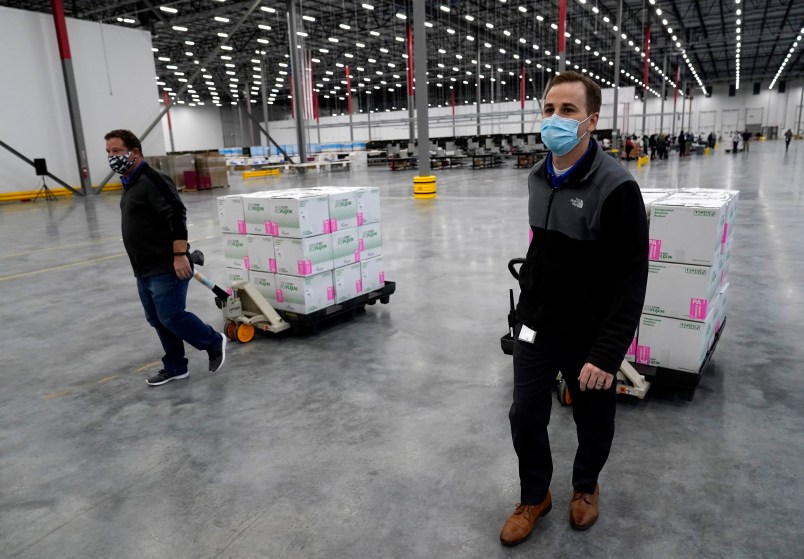The Trump administration’s botched COVID-19 vaccine distribution effort means more people will die and the dislocation caused by the pandemic will be prolonged, public health experts told TPM — and it may even put some doses at risk of expiration.
The criticism comes after the Trump administration failed to provide guidance to the states on how public health officials could implement the COVID-19 vaccine rollout, and as Congress appropriated billions of dollars for the distribution effort months after experts say it was needed.
Now, vials of the pandemic-ending shot are languishing in freezers without a destination, setting the effort to inoculate the country back by months. In Washington, D.C., and Louisville, some health workers have reportedly distributed doses at random to avoid allowing them expire before they were used.
“Every dose that is distributed should be administered,” said Dr. Leana Wen, a former Baltimore city health commissioner. “When you have thousands of people dying every day, it’s unconscionable to have any doses sitting in refrigerators and freezers when they could be given out.”
The lagging vaccine distribution effort comes after the Trump administration has boasted for months that it had fine-tuned a system by which the military would coordinate vaccine shipments around the country.
One official with Operation Warp Speed, the administration’s COVID-19 vaccine program, told reporters on an August 2020 call that the “biggest challenge so far is uncertainty, which creates a great number of scenarios, which creates complexity.”
“The American public can be reassured — I don’t see how we can work details more than we have been to address all of those different contingencies based on vaccine,” the official added.
Since then, Trump officials promised that 20 million Americans would be vaccinated by Dec. 31. That goal has been missed, with less than 5 million vaccinated as of this writing.
Meanwhile, the national vaccination effort has run into bottlenecks at the state level, with the federal government successfully dumping vaccine doses onto local governments that lack the resources to distribute them effectively. Congress only appropriated money for the effort last month — $8.75 billion — meaning that many state public health departments are at least weeks away from being able to use the funds, said Adriane Casalotti of the National Association of City and County Health Officials.
“They’ve been trying to do this and stand this up with no money with the same staff who have been on the frontlines of the coronavirus response since February and March,” Casalotti told TPM. “It’s not as if we were setting up for the largest mass vaccination campaign in our country’s history fresh; we’ve been playing for a long time.”
President Trump has heaped blame for the delays on the states, saying that they are “very slow to inoculate.”
Casalotti added that the current stage of vaccinations was “the easiest phase” — static populations in nursing homes and hospital workers — that are relatively simple to reach. The vaccination effort will only become more complex as it becomes more widely available.
“This is why we were asking for this money in the spring, and not now,” Casalotti said. “You can’t build an immunization infrastructure overnight, you can’t snap your fingers and then this exists.”
Wen likened the situation to what took place with testing and PPE in the spring, when the Trump administration relinquished authority — and responsibility — for procurement to the states.
“It should give all of us flashbacks to the testing debacle and to the pleas for help from health-care workers for PPE,” Wen said.
“This is a wartime effort,” Wen added. “We need a wartime mobilization by the federal government.”
The remarks come as some in the Republican Party have singled out the lack of planning by the Trump administration — and resulting delays — for criticism.
Sen. Mitt Romney (R-UT) said on Friday that the lack of a federal plan is “as incomprehensible as it is inexcusable.”
Josh Michaud, an epidemiologist at Kaiser Family Foundations, said that while the Trump-era CDC had issued guidance to the states on certain scenarios for vaccine distribution in September, it provided no uniform requirements for how to implement a COVID-19 vaccination program.
“There could have been a lot more forceful support from the government earlier in this process,” Michaud said, adding later that “it’s a mosaic of different approaches across the country, without much of an effort from the federal government to impose order.”
Howard Koh, a former assistant secretary for health during the H1N1 pandemic told TPM last month that the burden on local public health could have been avoided.
“So much of this could have been prevented and should have been prevented,” he said.



